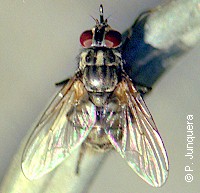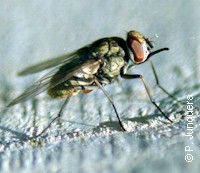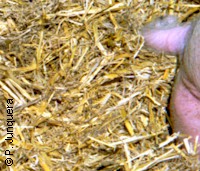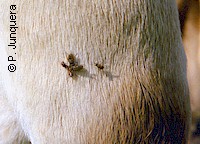Stable flies (Stomoxys calcitrans) are very common in any type of rural environment, especially in feedlots and dairy establishments, as well as in traditional pig operations, mainly in and around buildings.
Stable flies are usually less of a problem for sheep and goats. Stable flies will bite any mammal to suck blood, including humans, dogs and cats, as well as any kind of wildlife, and also poultry and other domestic birds.
Abundance is strongly dependent upon availability of pray and of climatic conditions. In countries with a cold winter they have a seasonal development with a population peak mostly in late spring and summer. In tropical and subtropical countries seasonality may depend more on rains and humidity, but flies may be present the whole year through.
Biology and life cycle of stable flies
Adult flies are 5 to 7 mm long. They resemble houseflies, but can be easily distinguished through their protruding mouthparts and the "checkerboard" aspect of the abdomen. For practical purposes, if there are flies around that look like houseflies, but they bite you, they are most probably stable flies.
Stable flies prefer to bite cattle in the legs, the flanks and the underbelly. Both males and females feed blood 2 to 3 times a day, each time during about 5 minutes although undisturbed they may feed for up to 15 minutes and suck up to 0,25 ml of blood. When not feeding they will rest near the hosts on fences, trees, walls of surrounding buildings, etc., at the sun if it is cold, in the shadow if it is hot. Stable flies can fly up to 40 km in one day.
The life cycle takes 25 to 40 days to complete depending on the availability of food and weather conditions. Each female lays 500 to 100 eggs during her lifetime, usually in batches of 25 to 50 eggs. They need several blood meals before being able to lay eggs. Preferred substrate for laying eggs is decaying vegetable material, e.g. hay, straw or bedding mixed with manure and urine, as is typically found in any livestock operation. Silage and rotting food are also suitable. Pure horse, cattle or pig manure is usually less suitable. Carcasses or decaying animal rests are not suited.
Life of an adult fly lasts 2 to 10 weeks. Overwintering stages in cold regions are pupae or mature larvae.
Click here to learn more about the general biology of insects.
Damage, harm and economic importance of stable flies

Stable flies can cause substantial economic damage to livestock, especially to feedlot cattle and dairy cows. Heavy infestations may reduce milk production by up to 60%. Infestations of about 50 flies/animal can reduce weight gains of calves by up to 1 kg per day.
The threshold for economic damage has been established at about 25 flies per animal. This damage is caused through the combined effect of blood loss (anemia) and stress due to painful bites and subsequent itching that leads to intense scratching and rubbing. All this may cause wounds that can be infected by secondary bacteria.
Hides can be substantially spoiled due to the numerous piercings of the skin during feeding.
Stable flies are vectors of serious livestock diseases such as various types of trypanosomiasis, anthrax, brucellosis, African horse sickness and fowl pox. On horses stable flies are vectors of Habronema spp, a gastrointestinal roundworm common in equids worldwide. Stable flies seem to be able to mechanically transmit anaplasmosis, as well as a number of other livestock viral and bacterial diseases such as foot-and mouth disease.
Non-chemical control and prevention of stable flies

Biological control of stable flies with its natural enemies has been intensively investigated. Spalangia spp and other hymenopteran wasps that lay eggs in the pupae of stable flies have been found to be the most efficient among the enemies of the flies. Acceptable efficacy has been achieved in confined poultry operations. However, results in cattle operations outdoors have been disappointing. The reason is that the wasps are not specific enemies of stable flies and when released outdoors they may find enough alternative prays that dilute their effect on stable flies. Learn more about biological control of flies and other insects.
Eliminating potential breeding sites such as rotting hay, straw or bedding, rests of silage and food, and any vegetable waste are essential measures to reduce the risks of development of large stable fly populations in dairy farms, feedlots, piggeries, etc. Stable flies can also be a strong nuisance in beaches and on the shore of lakes and other recreational waters where they easily find suited breeding places in piles of decaying algae or other plant debris. Elimination of such breeding places strongly contributes to reduce the populations.
Fly traps can be quite efficient. Best results are achieved with translucent glass-fiber panels impregnated with sticky glue; or with electrocuting screens with C02 as an attractant or equipped with fluorescent lights.
There are no really efficient natural repellents to keep stable flies away from livestock or pets.
There are no true vaccines that will protect livestock or pets from stable flies.
Click here if you are interested in medicinal plants for controlling flies and other external parasites of livestock and pets.
Chemical control and prevention of stable flies

Stable flies are difficult to control on the animals using insecticides, because they spend only a short time on the host. And being rather big, the dose of insecticide needed to kill them is substantially higher than for the smaller horn flies. In addition, they frequently bite the legs, which are poorly treated by most application methods (e.g. pour-ons, ear-tags, sprays, etc.), i.e. the concentration of insecticide on the legs is much lower than on the back or the flanks. And insecticides on the legs are more easily washed away when the animals go into water or simply graze on high pastures.
On top of it, since stable flies will bite anything that moves and is warm-blooded, many flies will not come in contact with treated animals. This means that stable fly population control is difficult in situations where there are enough alternative hosts (wildlife, the neighbors' untreated herds, etc.).
The good news is that stable flies do not develop resistance as easily and quickly as horn flies or houseflies.
Most products to control horn flies will provide some control of stable flies as well, e.g. dips, sprays, pour-ons and insecticide-impregnated ear-tags containing organophosphates and/or pyrethroids. As already mentioned, the legs will be poorly protected, but also the underbelly and the udders. These parts can be sprayed periodically if needed. Pour-ons or injectables containing endectocides are usually inefficient against stable flies.
Since stable flies enjoy resting on walls, fences, or trees near their hosts, spraying these resting places with contact insecticides (mostly organophosphates, carbamates or pyrethroids) can be quite effective. Translucent glass-fiber panels are more attractive to stable flies than black or colored panels. Putting such panels previously treated with insecticides in strategic places may ensure sufficient control.
A valid alternative to the use of insect adulticides is often to treat potential breeding places that cannot be eliminated with larvicides (e.g. organophosphates) or insect development inhibitors (=insect growth regulators = IGRs; e.g. cyromazine, diflubenzuron, etc). This can make a lot of sense in dairy, pig and poultry operations where this method is frequently used to control house flies as well.
There are not many options to protect dogs or cats from stable flies. A few collars with pyrethroids may give partial protection. Spot-ons, shampoos, soaps, sprays and similar products are not efficient against stable flies, or only for a few hours.
Many chemical repellents have been tried on cattle to protect them from stable flies. Those that showed some effect do not last more than a few hours, perhaps one day. This may be enough to protect a horse during a ride or a pet during a walk, but not to protect livestock. In addition, repellents have absolutely no impact on the fly populations. Most products based on pyrethroids offer a comparable repellent effect and kill flies too.
There is also additional information in this site on the general features of parasiticides and ectoparasiticides, as well as on parasiticidal chemical classes and active ingredients.
| If available, follow more specific national or regional recommendations or regulations for stably fly control. |
Insecticide resistance of stable flies
There are a few reports on stable fly populations resistant to organophosphates (e.g. dichlorvos) and pyrethroids (e.g. deltamethrin, permethrin) in dairy farms in the North America and Europe. However, it seems not to be a widespread problem, neither in the US, nor in most other countries. In any case, it is nothing comparable to the resistance problems of horn flies and houseflies.
This means that if there are unexpected problems to get stable flies under control in a given property, probably it is not due to a resistance problem, but to unusual conditions (weather, poor sanitation, etc.) that have favored their development, or to incorrect product choice or application. Incorrect use is the most common cause of product failure of parasiticides.
Learn more about parasite resistance and how it develops.